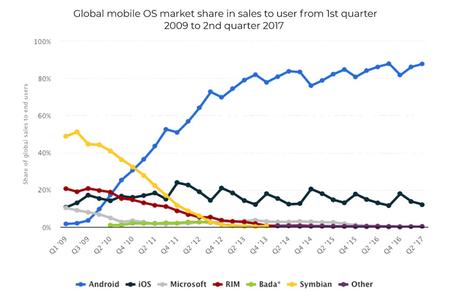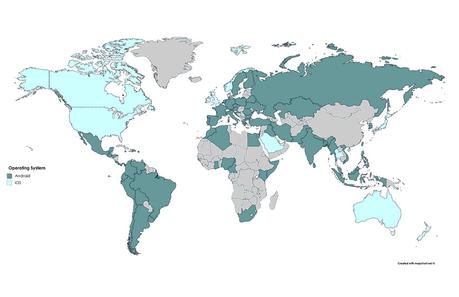
When business owners reach us, they are very clear with the idea of their product and what actions they want the mobile app users to perform using the application.
This clarity remains unshaken until the dimension of the concept is discussed from the technology perspective.
Our role in the mobile app development process begins from here, right from the discussing and briefing about the technology stack to mobile app usability and features.
For any business owner, it is crucial their technology partner understands their vision of the product. Only then, they can transform that vision into a workable product.
The initial phase of the transformation of the idea, including the blending of new ideas is all focused around increasing the acquisition, engagement, and retention of the customers, which seem interesting.
But it is these elements that increase product deviations and so in order to avoid this, both parties, the client and the mobile app development service provider must team up to create a concrete Product Requirement Document (PRD).
The PRD should address all the aspects of mobile app requirements critical to the application, such as hardware and operating system that application will run on, user perspective and preferences, and monetization or revenue model.
When teaming up for defining mobile app requirements, most of the clients feel the pressure of technology and its complexities.
In here, we have discussed 5 frequently asked questions by clients during defining mobile app requirements. The objective is:
- To ease out business owners that technology may look difficult at times, but have been designed to make things simple and secure for end users.
- To help them understand that technology and its complications can be handled smoothly with experience and technical expertise.
5 Frequently Asked Questions During Mobile App Development Requirements Setting
When preparing a mobile app requirements document, project managers should carefully weave one requirement of the project seamlessly into another. This would help them to avoid any surprises or missing an element during the development process.
Besides, clients should also be very open at this stage related to their needs and expectations. Any unattended confusion at this stage can lead to misunderstandings between app developers and mobile app owners.
Here, we have jotted down 5 frequently asked questions asked by clients during the requirement setting stage.
- Which is better: Native App Development or Cross-Platform App Development?
- What mobile platform should we target?
- What would be preferred backend language and databases?
- What about the Roles and Permissions?
In the native app development, we use the default language and IDE of the operating system. For iOS, it is Objective C/Swift with XCode and for Android, it is Java/Kotlin with Android Studio.
When it comes to cross-platform app development, the coding is done on the selected technology framework and then it can be deployed in Android, iOS, and Windows phones.
Selecting a mobile app type largely depends on your project requirement and targeted audience. Your decision to go for native app development or cross-platform app development must be specific to your targeted audience and UI and UX features you want in your app.
Note that Native apps fair highly in App Stores and function impeccably on their specific platform. However, native app development is a time-consuming and expensive process that require more skillful developers.
Developing Hybrid apps are less costly and consume less time in the development process. Besides, these are easy to launch an update, though, there are performance and integrations issues with the Hybrid apps.
iPhones and Android smartphones are in fierce competition and both the platform are growing at a significant rate.

Source: https://steelkiwi.com
Where Android market share is growing since 2013, Apple is still the undisputed king in the North American region.

Source Device Atlas
So, before you pick any platform, you need to tally it out with your mobile app market.
We would recommend you to go for both the platforms if you are a growing business, willing to explore international territories in near future. If your business is local, you can check out the mobile platforms used in the nearby regions and accordingly pick the one.
Node.js and Java are two common preferred backed languages for mobile app development. Node.js allows you to write code for both client side and server side and so it makes easier for the developer to use JavaScript for both sides.
Whereas, when you write in Java, you have to rewrite the same code in JavaScript for the client side.
Although, Java has better IDEs, like NetBeans, Eclipse, and IntelliJ, which are well-integrated with decompilers, debugger, severs. These IDEs enable app developers to create a robust ecosystem with plug-ins.
Other common backend languages that your database can recognize are Ruby, .Net, and Python.
Bad mobile networks can fail even great software.
To avoid this reliance on the network, many databases and cloud service providers are adding synchronization and offline capabilities to their mobile solutions, which enables the mobile app to work both online and offline.
Depending upon your budget flexibility, you can pick the solutions such as Amazon's Cognito and Microsoft's Azure Mobile Services.
Besides, you can manage your customer and product information on a local server built on MySQL, MongoDB, PostgreSQL, Cassandra, and SQL Server.
Access control and permission management functionalities can be categorized into three parts:
- Content access: Control which part of the space can users view and access. The access controls can either be shared with individuals or the admin.
- Data access: Controls which data users or groups can view. Data access can be restricted to the users or groups through Model sets, using access filters and access grants.
- Feature access: What actions can users perform in the mobile app. Permission sets can be created to specific model sets and accordingly a user-defined dashboard can be created.
The access control functionalities help to determine what users can do and look in the mobile app and how and what part of the data could be shared with users and admin panel.
What level of security is required?
Defining security requirements is a whole new ballgame.
Preparing the security requirement list at the very initial phase of the mobile app development process is crucial to building a robust and secure software application.
- Weaker server-side controls: Server is extremely vulnerable to hacking because any communication between the app and the user happens through the server. To overcome server-side security challenges, you have to make sure that mobile app developers working on the project have security-specific knowledge of the programming language. Server-side security is more vulnerable when you are working on a cross-platform mobile app development project.
- Insecure data storage: Securing data storage across platforms is essential. For the same, app developers must not depend on client storage for the data, rather take additional storage space for safety.
- The Absence of binary protection: Use of binary hardening techniques in which binary files are analyzed and modified to fix the legacy code without the need for source code could help to increase mobile app security. In case of lack of binary protection, rouge competitors or hackers can reverse engineer the code and redistribute the application injected with malware.
- Insufficient transportation layer protection: You need to protect the route through which data is transferred from the client to the server. By using SSL and TLS encryption, you can protect the data from hackers. However, not all SSL are same, and so while picking the SSL, you must ensure to use industry standard cipher suites with proper key lengths.
- Poor authentication and authorization: Mobile app internet connections are unreliable and so sometimes offline authentication is required to maintain the uptime.
- Broken cryptography: Poor handling of encryption process from sheer over-reliance on built-in encryption process to the use of custom encryption protocols and insecure algorithm leads to broken cryptography. Hackers can use it as an opportunity to exploit the vulnerabilities to steal the data according to their convenience. This security threat could be avoided by using advanced encryption protocols and processes.
- Improper session handling: This is a client call, as many a time, companies purposely keep the session longer to not to interrupt the buying process. In uncertain conditions, if the users' device gets into wrong hands in between, chances of data manipulation and stealing get increased.
- It is recommended to use re-authentication for critical actions like purchases or important documents.
In the offline mode, apps are not able to differentiate between users, thereby allowing users with low permissions to execute the actions. Hackers can brute force through the security logins and perform actions that are only limited to admins or super admins.
In order to prevent the execution of actions in offline mode, you have to limit actions to online mode only and encrypt the data that can be opened in offline mode.
A mobile app gets many security threats, which are usually due to the following reasons:
Your mobile app can encounter any of these security threats and so you have to be prepared to handle these situations without being threatened by the hackers.
These are the common questions of our Project Managers directed at. Here, we have not included questions specific to UI and UX as most of those questions are project related. If you have any other questions related to mobile app development, write to us at [email protected] and we promise to get back to you shortly.

posted on 06 November at 14:06
Thank you for this article informing about such an important topic! From my personal experience I know building an effective Android app can be challenging. So, I would recommend to anyone who struggles with same kind of problem to check out this agency called Eleken. This is the company I personally trust and if you try working with them I
m sure you wont regret it too. You can look at their website https://www.eleken.co/mobile-app-design if you want to see some examples of their previous works. Hope this can be useful to anyone :)